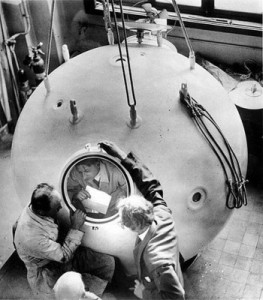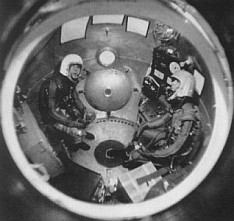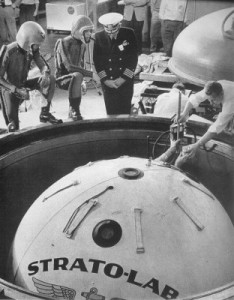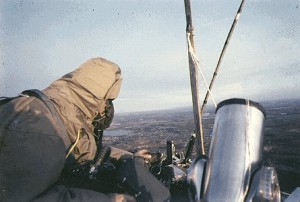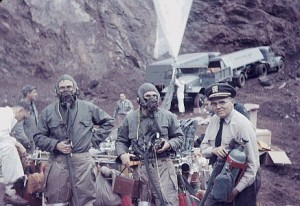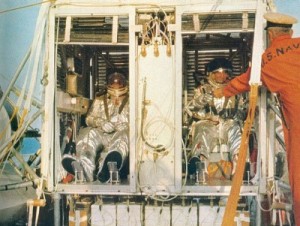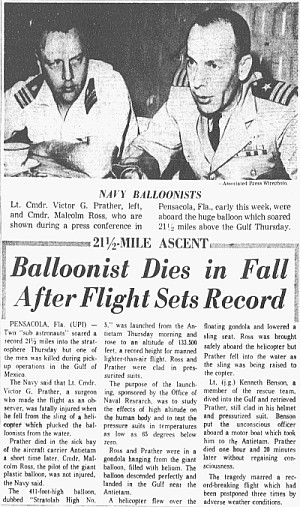The 1930s witnessed the first balloon ascensions into the stratosphere using sealed, pressurized gondolas. Professor Auguste Piccard was the first person to use a pressurized cabin for a stratospheric flight on May 27, 1931. He and Paul Kipfer reached an altitude of 51,777 feet over Augsburg, Germany. During the next four years, there were nine more expeditions to the stratosphere launched in the United States, Europe, and the Soviet Union. This period of balloon flight culminated with the US Army Air Corps/National Geographic Society balloon Explorer II. On November 11, 1935, Explorer II reached an altitude of 72,395 feet with Captains Orvil A. Anderson and Albert W. Stevens on board.
The balloons used for these early flights were all made from rubber coated fabric. Explorer II represented the practical limit for a balloon made from rubberized fabric. To venture higher, new materials were needed. Auguste Piccard had an identical twin brother, Jean, who immigrated to the United States in the 1920s. Jean was also interested in exploring the stratosphere and made such a flight with his wife Jeanette on October 23, 1934. The Piccards used the Century of Progress balloon to reach 57,979 feet. While this was well short of the altitude record, Mrs. Piccard became the first woman to reach the stratosphere
During 1935, Jean Piccard, worked with Dr. Thomas Johnson of the Bartol Research Foundation of the Franklin Institute, to construct a cellophane balloon which he launched at Swarthmore, Pennsylvania. The following year, Piccard continued his work with cellophane balloons and launched them from the University of Minnesota stadium. The Second World War interrupted high altitude ballooning, and there was a long hiatus before anyone again used an aerostat to reach the stratosphere.
After World War II, Jean Piccard, who was then with the University of Minnesota, proposed another stratospheric balloon project. He was introduced to Otto Winzen, chief engineer for the Minnesota Tool and Manufacturing Corporation, who agreed to work with him. They approached the United States Navy with a proposal they called Pleiades II. (Before the War, Piccard had developed a low-altitude clustered balloon aerostat he called Pleiades.) Pleiades II would use a spherical capsule carried to an altitude of 100,000 feet by a cluster of cellophane balloons. The Navy created a Technical Committee under the leadership of Commander George Hoover at the Office of Naval Research (ONR) to manage the effort, which they renamed Helios.
Realizing the limitations of cellophane, Winzen and Piccard sought a better balloon material. They needed a material that was lightweight, inexpensive, and strong. It had to remain flexible in the frigid upper atmosphere and be relatively unaffected by ultraviolet radiation. Finally, a suitable material was found: polyethylene. Available in very thin sheets, it remained pliable over a wide temperature range, was unaffected by ultraviolet radiation, and cost a fraction of what rubberized fabric did.
Because of its proximity to the University of Minnesota, Piccard asked General Mills to build the Helios capsule. It was a 7-foot, 2-inch diameter sphere, made from eight segments of 1/8-inch thick aluminum. Jean Piccard based the Helios design on the capsules used by his brother Auguste in the 1930s. In many ways Helios remained anchored in 1930s design. For example, Piccard proposed using chemical scrubbers in cabinets to remove carbon dioxide that were very reminiscent of the design used for Explorer II. Shortly after work started on Helios, Winzen went to work for General Mills and led the team that designed their first plastic balloon.
Winzen's first plastic balloon, which he launched on September 25, 1947, had a volume of 30,000 cubic feet. He felt 200,000 cubic foot balloons were a realistic goal, but this was still inadequate for Helios. Helios would need a cluster of balloons totaling 14 million cubic feet to reach an altitude of 100,000 feet. In other words, Helios would need at least 70 balloons! Realizing the impossibility of trying to launch such an unwieldy cluster, the Navy canceled Helios in late 1947. General Mills had already finished the capsule shell, which was placed in storage.
Strato-Lab born
The ONR asked Winzen to instead concentrate on building large individual balloons. This endeavor became known as Skyhook. Winzen left General Mills in 1948 and started his own company, Winzen Research, Inc. (WRI). In the mid-fifties, the Navy revived their interest in manned stratospheric balloons. In 1954, the ONR appointed an advisory panel to review proposals they had received for manned balloon projects. The resulting program was named Strato Lab and Winzen Research received the contract to build the gondola. To save money, Otto Winzen convinced the Navy to let him refurbish and modify the Helios shell.
Strato Lab had two inward opening hatches mounted in flat frames. Having two hatches made normal entry and exit easier and facilitated rapid exit in case of an emergency. Simple air pressure sealed the hatches. Within the cabin, a pressure equivalent to 17,000 feet was maintained. When the balloon ascended beyond that altitude, the pressure difference between the inside and outside atmospheres forced the hatches against their frames. A silicone O-ring around the outer diameter of each hatch created a pressure-tight seal. During descent, the hatches opened automatically.
Strato Lab used a two-gas atmosphere supplied by two separate cryogenic systems. One contained five liters of a mixture of 50% liquid oxygen and 50% liquid nitrogen. The second five-liter converter contained only liquid oxygen. It provided an auxiliary supply for emergency cabin pressurization and supplied oxygen to the pilots' pressure suits. Together, these provided a 72-hour oxygen supply for two pilots. Lithium hydroxide and lithium chloride removed carbon dioxide and water vapor, respectively, from the cabin atmosphere. A fan forced cabin air through a cabinet that contained the chemicals. Air pressure inside the cabin was automatically maintained by a pressure regulator built by the Firewel Company in Buffalo, New York. As a back up to the cabin life support system, the pilots wore Air Force MC-3 partial pressure suits.
The gondola had nine windows, sealed with 3/4-inch Plexiglas. A black and white paint scheme like that used on Explorer II provided passive thermal control for Strato Lab. Fans inside the cabin blew air over either the warm lower half or cooler upper half, depending on the inside temperature.
Strato Lab was suspended from the balloon via an open 64-foot diameter nylon cargo parachute. Despite the tremendous strides that had been made in balloon reliability, occasional failures still occurred so the parachute was necessary. Also, if the crew were incapacitated, ground control could cut away the gondola. If both the balloon and cargo parachute failed, the pilots had personal parachutes.
First flights for the project
Strato Lab included flights in the pressurized gondola and open baskets. Lieutenant Commanders Malcolm D. Ross and M. Lee Lewis made the first manned flight of the Strato Lab program in an open gondola. They ascended to 40,000 feet on August 10, 1956, to photograph condensation trails from jet aircraft. Secondary objectives were to make physiological measurements of the pilots and test their pressure suits.
Ross and Lewis made the first flight in the pressurized gondola on November 8, 1956. Strato Lab High 1 reached 76,000 feet. Shortly after reaching altitude, the vehicle began to descend on its own. At first, Ross and Lewis feared the balloon had torn. Once they reached 17,000 feet, they opened the hatches and began tossing equipment overboard. Ross and Lewis brought the descent under control and landed in the capsule near Kennedy, Nebraska. No tear was found in the balloon; there had been a problem with the vent valve.
The Navy completed the second Strato Lab High mission on October 18, 1957. Piloted once again by Ross and Lewis, Strato Lab High II reached 85,700 feet on October 18, 1957. They spent several hours above 85,000 feet in a flight that lasted nine and a half hours.
Strato Lab High II was relatively routine, the only negative aspects of the flight being uncomfortably high temperatures and humidity in the capsule. When they began their descent a little past noon, the temperature inside the capsule was nearing 80o and the relative humidity was around 60 percent. Wearing Navy thermal garments over Air Force pressure suits, Ross and Lewis were extremely uncomfortable. This seriously affected their ability to complete scientific observations. The flight journal contained the following remarks written after they conducted an instrument reading: "About stood on my head to do this. After several readings gave up. Strato-Lab of the future (as our manned satellites) must be far different if scientists are expected to work and do real research."
Ross again ascended into the stratosphere on May 6 - 7, 1958, this time accompanied by Alfred H. Mikesell, a Naval Observatory astronomer. They flew in an open gondola, and did not wear pressure suits. The aeronauts wore oxygen masks and Navy cold weather gear. Reaching 40,000 feet, Mikesell became the first astronomer to conduct observations from the stratosphere.
Ross and Lewis ventured into the stratosphere together again for Strato Lab High III on July 26 - 27, 1958. They reached 82,000 feet and remained aloft for near 35 hours. Not long after this flight, Lewis retired from the Navy and joined the staff of Winzen Research as chief of operations. The fourth Strato Lab High flight took place on November 28 - 29, 1959. Commander Ross and Charles Moore reached 81,000 feet. For this flight, the capsule carried a 16-inch telescope so Moore could observe Venus.
Success and tragedy
Even though NASA had responsibility for human space flight, the Navy continued their Strato Lab program. In May 1961, on the eve before America's first manned space flight by Navy Commander Alan Shepard, two other Navy officers ventured to the edge of space beneath a plastic balloon.
Strato Lab High V, the last in the series, was different from previous flights. Instead of using a pressurized capsule, Strato Lab High V used an open gondola. Commander Ross commanded this flight. Lt. Commander Victor G. Prather, a medical officer from the Naval Medical Research Institute in Bethesda, Maryland, accompanied him. The main objective of the flight was to test the Navy's Mark IV full pressure suit. Manufactured by B. F. Goodrich, the Mark IV was the basis for the Project Mercury space suits. Strato Lab High V was the most severe test of the suits ever conducted.
Ross and Prather took off from the deck of the aircraft carrier USS Antietam on the morning of May 4, 1961. The balloon envelope was the largest ever launched -- 10 million cubic feet! It was made from seven acres of polyethylene and weighed a ton. Fully inflated, it was 300 feet in diameter. The carrier was in the Gulf of Mexico, steaming with the wind so the air speed on the deck was zero.
Ross and Prather endured bitterly cold temperatures, condensation on the visors of their helmets, and communications problems during their ascent. Despite these difficulties, they reached 113,740 feet. As later reported by Ross: "In silent awe, we contemplated the supernal loveliness of the atmosphere." It was 9:47 a.m., a little more than two and a half hours after launch.
Ross decided to begin descending almost right away, but at first could not establish a steady rate of descent. By 11:15, they were still floating at 110,000 feet. Ross mentally plotted their descent rate versus time versus oxygen supply and realized they could very well run out of oxygen if they didn't descend soon. Ross finally achieved a steady descent rate, but found it was too fast. He and Prather quickly began jettisoning ballast.
Even after dropping all the ballast, Strato Lab continued to descend too fast, so they began throwing everything they could overboard, including the radio. The aeronauts brought the descent under control and even relaxed enough once they were below 7,000 feet to open the visors on their helmets and smoke cigarettes. When the gondola splashed down in the Gulf, Ross released the balloon. They sat there, floating comfortably, surrounded by the debris they jettisoned during the descent.
The Antietam was just a mile and a half away. With rescue helicopters overhead and the aircraft carrier approaching, Ross and Prather were in a jubilant mood, knowing they had completed all the objectives of the flight. As the helicopter moved into position, it lowered a line to the pilots. Ross went first. Stepping on the hook at the end of the line, he slipped and fell into the water but held onto the line and was hauled aboard the helicopter. When it was Prather's turn, he also slipped and fell into the water, but was unable to keep hold of the line. Seawater poured into his suit through the open face plate. Rescue divers were quickly in the water, but they were too late -- Prather drowned. Prather's tragic death devastated Ross and marred what was otherwise a brilliant flight.
The day after Strato Lab High V, an American crossed the threshold from "space equivalence" to outer space for the first time. On May 5, 1961, Navy Commander Alan B. Shepard, Jr. became the first American in space with the sub-orbital Freedom 7 mission.
In many ways, Strato Lab can be perceived as an evolutionary stepping stone to space flight. Unlike the contemporary Manhigh program by the United States Air Force, which used a brand new capsule design and an innovative life support system, Strato Lab retained the configuration and certain design elements of balloon gondolas of the 1930s. Thus, it bridged the gap between pressurized gondola designs of the 1930s and modern spacecraft. In addition, Strato Lab was the first post-war balloon project to carry humans into the stratosphere and it pioneered having a trained scientist on board to make observations while a pilot handled the aircraft.
About the author
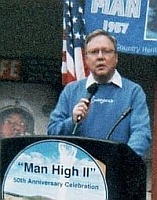
Gregory P. Kennedy is an internationally known expert in aerospace history. He has authored, co-authored, or edited eight books on space history including Touching Space: The Story of Project Manhigh, which was released by Schiffer Publishing Company of Atglen, Pennsylvania (www.schifferbooks.com).
He has also published numerous articles on the Manhigh project and recently appeared on a PBS documentary entitled "Space Men".
With nearly 40 years' experience in aviation and space museums, Mr. Kennedy has worked at the Smithsonian Institution; the Space Center; American Airlines C. R. Smith Museum; and No. 1 British Flying Training School Museum. While at the Smithsonian, he was Associate Curator for the National Air and Space Museum's collection of manned space flight artifacts.
It was during his tenure at the Smithsonian that he became fascinated with Project Manhigh and the contributions of high-altitude ballooning to space exploration. At the Space Center (currently known as the New Mexico Museum of Space History) in Alamogordo, New Mexico, Mr. Kennedy met many Project Manhigh personnel.

